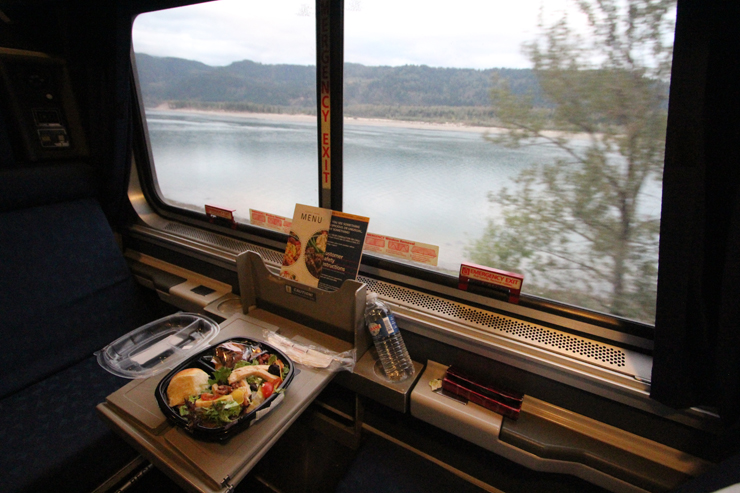
Bob Johnston
CHICAGO — Food service on Amtrak’s long-distance trains has become such an exercise in repetition that something as modest as the cold meal service on the Portland, Ore., section of the Empire Builder is both a notable and welcome respite.
That’s one aspect of the current state of onboard dining, which suggests both immediate and future alterations.
The cold meals are offered to sleeping-car passengers because the Builder’s dining car operates on the Seattle section of the train that joins or splits at Spokane, Wash., on its way to or from Chicago. It’s a cost-effective compromise that makes sense. While Portland coach passengers can purchase cafe fare downstairs in the Sightseer Lounge, travelers in the sleeper have been served a continental breakfast westbound, with deli-style options for the eastbound dinner.
When Trains News Wire made the connection from the northbound Coast Starlight in Portland in late October, a fig and chicken salad was one of only two choices offered. But the tasty boxed dinner, which also includes shaved parmesan cheese, balsamic dressing, sliced apple, and a brownie, provided welcome variety from the eight meal-in-a-bowl “Flexible dining” alternatives served at both lunch and dinner to sleeping-car passengers on all western trains.
These meals migrated from the single-night eastern trains to their western counterparts in July, as Amtrak opted to reduce labor costs while facing uncertain demand, at the same time sleeping car patrons might reasonably expect room-service meals to maintain social distancing. In those conditions, transporting silverware, entrees, side dishes, beverages and deserts would be difficult to execute.
The western lunch and dinner menus were expanded slightly, although fresh fruit was dropped from an already woefully thin breakfast lineup. Other than oatmeal, the only hot morning item served from the dining car is an Egg McMuffin-style breakfast sandwich. The café sells a similar item, as well as a satisfying sausage, egg, potato and cheese “breakfast bowl” that was sampled on the California Zephyr.
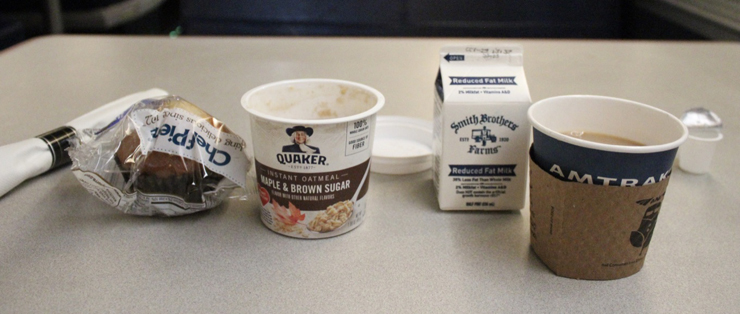
Bob Johnston
Meanwhile, the issues created by limiting dining cars to sleeping-car passengers remain. Telling passengers who wander into the diner ready to spend money that they need to go somewhere else, plus full-train p.a. announcements regarding meal times “for sleeping car passengers only,” amplify a needless “us and them” atmosphere.
On the Empire Builder and Lake Shore Limited — with Portland and Boston sleepers, respectively, isolated up to six cars from the dining car — the long walk is hardly worth the meal, or the “where are your papers?” ticket examination by the service attendant that usually follows, since the sleeping car passengers are entering from a coach. (It also happened to News Wire on the Coast Starlight.) At lunch as the Builder crossed southern Wisconsin, this aggravation was avoided by having Jay, the Portland sleeping car attendant, make the long trek for “plant-based protein, black bean, corn and cheese enchiladas.”
Improving the experience
The October trip offered several conclusions on how dining can be improved:
More help. Even with every other table off-limits to seating, the California Zephyr’s lone dining car attendant had trouble keeping up with demand. He was the only person to retrieve heated meals off the dumbwaiter from the cook downstairs, fill drink orders, clear the disposable packaging, and then diligently wipe down tables after each use. As a result, customers could use only half the spacious Superliner diner — in other words, a quarter of the seating. On the Starlight and Empire Builder, both sides of the car could be used because an additional attendant from a coach or sleeping car assisted. This reduced wait times and allowed service to more customers.
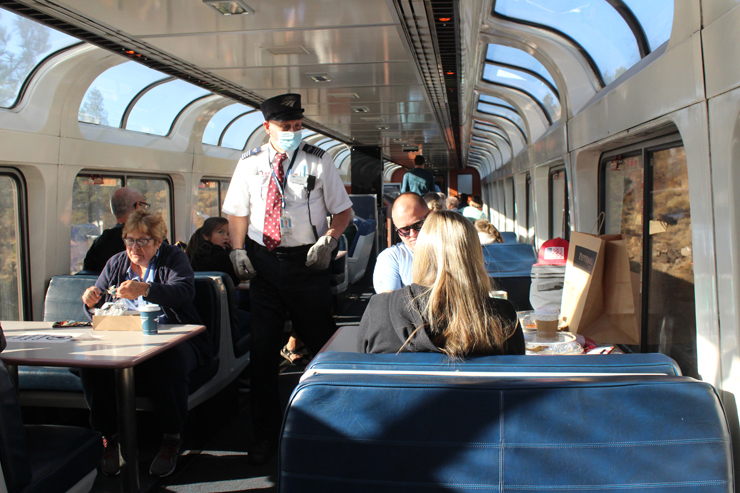
Bob Johnston
Menu choice. Relying on stopgap “flexible” meals is an understandable necessity during the pandemic. But repeating the same options and bowl format four or five times on the same trip, with more of the same for anyone connecting from another train, can’t be sustained indefinitely — not when sleeping car passengers pay more than $400 per night or are redeeming tens of thousands of Amtrak Guest Rewards points. The perfunctory food offerings diminish and devalue a travel experience that Amtrak has already seen attracting new customers during the pandemic.
Table service for all. Sightseer lounge tables on the California Zephyr, Coast Starlight, and Empire Builder were constantly busy; passengers generally wore masks when not eating the food they brought with them or purchased in the cafe. On the Canadian, which this week makes its first Vancouver, B.C., to Winnipeg, Manitoba, round trip since March, VIA Rail Canada is serving breakfast and dinner to its Sleeper Plus travelers by reservation in the dining car. This was also the preference of many Amtrak sleeping car passengers on the October journey. Restoring access to the diner for all passengers as staffing and food options are increased can eliminate the sequestration aspects and limitations of the existing service.
Affordable selections. There is also an opportunity to overhaul a revenue model that predates the pandemic. Currently, dining costs are allocated from tickets already purchased, since meals are included for sleeping-car patrons. But less pricey offerings could attract new dollars from coach passengers. Historically, breakfast has been a high-demand meal for everyone on the train, and more recently the company had success with at-seat $12 “Just for you” dinners prepared by dining car staffs in advance of evening meal periods. Similarly, having passengers pay for easily inventoried alcoholic beverages would grow revenue. Though the first glass is complimentary, budget Barefoot wine is currently the only brand offered.
Although the public’s perception of travel risk isn’t likely to change until vaccine distribution is more widespread, the need for people to travel will only intensify as 2021 progresses. While the additional expense of bringing back experienced staff can adversely affect the bottom line in the short term, enhanced food service can have a positive impact as Amtrak attempts to grow its business.
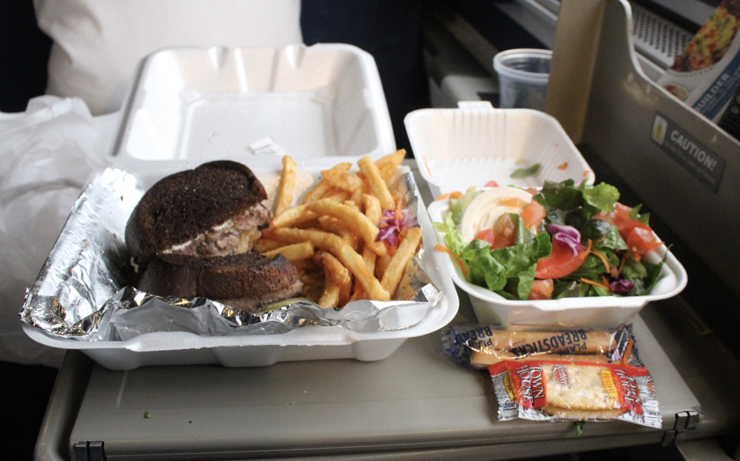
Bob Johnston
One way to get a respite from the Amtrak menu
On the Empire Builder, it is possible to take a break from the packaged Amtrak meals: chicken Marsala or fettuccini, shrimp with Andouille Creole or lobster sauce, meatballs, braised beef, or Asian Noodle Bowl. Although the vendor who used to deliver chicken dinners to the train with Amtrak’s blessing at Havre, Mont., is no longer in business, travelers can call ahead and order a meal from PJ’s Lounge, across the street from the station. The eastbound train was running an hour late owing to BNSF Railway trackwork, but conductors advised that the locomotives would be fueling for 15 minutes — long enough to get the food and bring it back. Alas, this off-train option isn’t available at intermediate stations on most routes, and passengers attempting take-out must verify departure times and their intentions with the operating crew to avoid a two- or three-day wait for the next train.








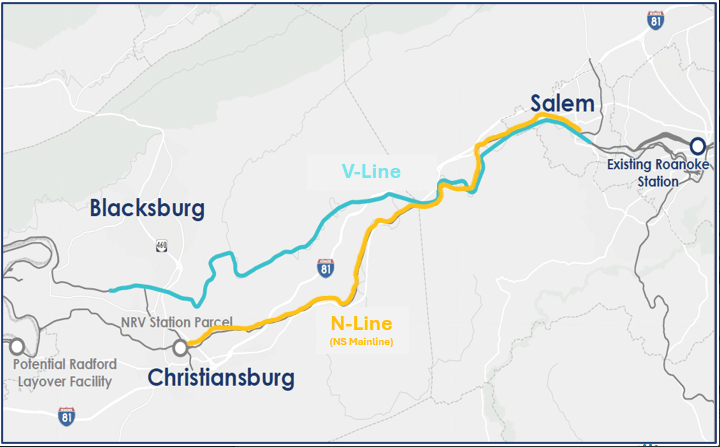





Never having riden on Amtrak til retirement I have been excited about the prospect of sleeping car accommodations with table cloth and actual silverware on china plates for the meal service. I thought this classiness would really add to the train travel experience. But, now, after reading this article and seeing the extremely reduced dining service on eastern trains, I’m going to have to seriously rethink if train travel will be worth the additional cost. I’m going to continue following updates and, in light of the billions Amtrak is spending to upgrade the service, I hope Amtrak comes to understand how much the experience of fine dining is worth putting money and innovative, creative menus back on the trains. (With tablecloths, silverware and china. Fresh flowers would be appreciated also.)
Sorry for the length of this comment, but really wanted to speak my piece.)